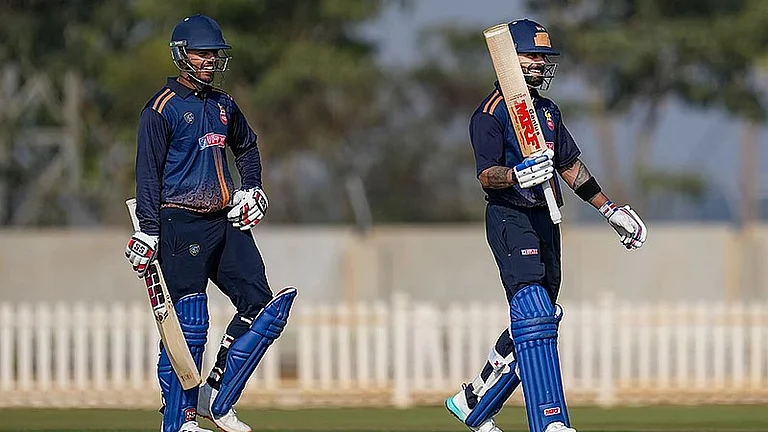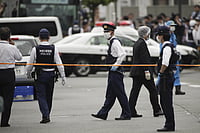People on both sides of the divide have argued themselves hoarse on whether the Indian nuclear power programme is a white elephant. But that this money-guzzling pachyderm of a programme can also go on a destructive rampage has come to light only recently. Technical experts are gravely concerned about the safety of India's nuclear plants which had promised 20,000 MWe of power by year 2000, but are down to producing 1,840 MWe. The alarm, therefore, is not with the worthless spending of thousands of crores, it's got to do with human lives.
The recent nuclear accident at Tokaimura nuclear plant, 110 km off Tokyo, which shocked the world, could well happen in India, they point out. These are not anti-nuke voices. They belong to the proponents of the nuclear energy programme. India, according to them, has been saved from a nuclear disaster by dint of luck.
A. Gopalakrishnan, former chairman of the Atomic Energy Regulatory Board (AERB), says, "The threat of a serious accident at nuclear plants is real. The emergency cooling systems of reactors in atomic power plants of Chennai and Rajasthan are inadequate. Besides, the two reactors at Tarapur must be closed immediately."
In 1985, India had six units running with a total capacity of 1,360 MWe. A 15-year plan with the "20,000 MWe by 2000 AD" target was set into gear. Today, India has 10 operating reactors with a combined capacity, well below the projected level.
What lends credence to critics of India's nuclear power programme is the secrecy that shrouds it. The Indian Atomic Energy Act, '62, gives the department of atomic energy (DAE) enormous power as well as the right to withhold information; it is not even accountable to Parliament. Consequently, the department has neither listed out the accidents nor has it been forthcoming on the real status of reactors.
However, the nuclear establishment has gone on record saying that it is open to questioning and that it gives safety top priority. Says Y.S.R. Prasad, chairman and managing director of the Nuclear Power Corporation and a member of the Atomic Energy Commission: "I'm operating the plants and my people are working there. The onus is on me to see that they are safe. I can assure you that our plants are fail-proof. If anything happens, the reactor shuts down. Besides, if one shut-down operation fails, the other comes to rescue."
But the AERB compiled a Safety Issues Document in 1995 which lists 134 items relating to accidents, weaknesses in the safety systems, procedural flaws and equipment failures. It is a classified document and has never been released. "I do not understand how we can release it. The Bombay High Court has also upheld the department's view-point," says Prasad.
A close look at various nuclear power stations in the country, however, unsettles the comforting picture drawn by Prasad. Here are our key power plants:
Tarapur Power Station (TAPS 1 and 2): These two reactors, with an original power rating of 210 MWe, constructed with US cooperation and commissioned in 1969, are still operational. Currently, however, no similar reactors function anywhere in the world.
The problems with the two Tarapur reactors are manifold. First, they share the same emergency core cooling system, in violation of all safety standards. Besides, parts of TAPS are out of bounds for inspectors, and nor do the Indian scientists have the technology to inspect it. This has been compounded by zero US assistance after Pokhran-I in 1974. The two steam generators in each unit are totally disabled owing to extensive tube failures and because of this TAPS has been de-rated from 210 MWe to 160 MWe. The most disturbing aspect, however, is that the use of nitrogen to make the containment unreactable (inert) has been discontinued. Therefore, if the coolant does not perform its function, an explosion is quite likely to occur, leading to reactor meltdown.
But the npc chairman argues that de-rating is good because it puts safety above everything else. Says Prasad: "We've developed our own testing systems and tools. In our opinion, TAPS has a life of another seven to 10 years." He also explains the suspension of nitrogen use in the containment saying that it is obsolete in the West. But what he fails to mention is that the US, for instance, has moved to higher capacity reactors and the ones similar to those at TAPS have long been shut down there.
Rajasthan Atomic Power Station (RAPS 1 and 2): These were the first pressurised heavy water reactors in the country, supplied by Canada. Though they were rated at 220 MWe, their efficiency was very low to begin with. Explains Prasad: "In Canada, the temperature of water is about four degrees centigrade whereas it is as high as 30 degrees centigrade in Rajasthan. The temperature variance led to its de-rating." The real reason, however, is not just the difference in temperature.
One of the end-shields at raps-1 developed cracks, leading to leakages. If the de-rating was only due to the temperature difference it would not have been more than 20 MWe, but poor quality control forced the plant to be de-rated from 220 Mwe to just 100 Mwe.
Another issue, which is of grave concern, is the status of the pressure tubes. The nuclear fuel is housed within a pressure tube which passes through another tube with the gap between the two filled with a gas. In the first seven instances, the pressure tubes were made of Zircalloy-2 which was later found to be prone to deformation under irradiation. The Canadian model, along which the Indian tubes were developed, has fully changed to a better zirconium-niobium alloy. This, however, has not been carried out at raps1. Besides, there is no adequate high-pressure emergency core cooling system (ECCS) there. This system is crucial to prevent core melt-down.
Madras Atomic Power Station (MAPS 1 and 2): These two reactors have created a world record of sorts by being in the gestation phase for more than 15 years. maps1 was commissioned in '84 and MAPS 2 in '86. Within a couple of years of commissioning, both their reactor inlets cracked. This happened because the DAE didn't heed Canadian advice on how to set the reactors up. And they didn't have a clue.
The MAPS reactors were de-rated from 235 MWe to 175 MWe because of this and their continued operation even in this mode is not considered safe. The various safety issues in MAPS 1 and 2 puts this Tamil Nadu station in a risk category unacceptable anywhere else in the world. MAPS has also witnessed many instances of heavy water leak.
Narora Atomic Power Station (NAPS 1 and 2): These two reactors with a capacity of 235 MWe each were commissioned in 1991 and 1992 respectively. A major fire at NAPS 1 helped in foregrounding a problem with the original turbines in the pressurised heavy water reactors. The General Electric Company (GEC), which designed the turbines, discovered that there was a problem with the turbine blades. In 1989, GEC promptly provided a revised blade design to Bharat Heavy Electricals Limited (bhel). bhel, in turn, prepared detailed drawings for new blades for Narora, Kakrapar and Kaiga. But the DAE did not take action till a fire on March 31, 1993, brought the Narora Unit 1 very close to a meltdown. Consequently, the AERB ordered closure of all heavy water reactors in the country. Says Gopalakrishnan: "It was a case of callous management. At other plants, the blades were cracking exactly at the same point as in MAPS-1." Efficient handling of the crisis by the shift engineers at the plant saved the day.
Kaiga 1 and 2: In 1994, a concrete containment dome collapsed, thanks to faulty design, during the construction of the Kaiga power station in Karnataka. This collapse led to a delay of nearly four years. In September last year, Kaiga 2 was commissioned ahead of Kaiga 1. According to AERB sources, the DAE is refusing to learn from its mistakes.
AERB had directed the DAE to carry out an integrated ECCS testings in Kaiga 1 and 2 as well as raps 3 and 4 before start up. It also wanted proof and leakage tests conducted on the reactor containments. And finally, a full-scope simulator to be installed for operator training. None of these directives have been complied with so far.
Kakrapar Atomic Power station (KAPS 1 and 2): These plants with a capacity of 220 MWe each were commissioned in May 1993 and May 1995. They house the first indigenously-developed microprocessor-based control system. Most experts feel that Bhabha Atomic Research Centre (BARC), which has developed these systems, did not test them thoroughly for lack of equipment. In this station too there was flooding in 1994 like at raps.
The only way, therefore, to tackle these safety threats is to make the AERB a truly autonomous body. Right now it's an organisation held captive by the DAE. Prasad, however, is unwilling to even concede this and cites a couple of instances to substantiate his case.
Autonomy for nuclear power regulatory bodies is essential if they are to have some teeth. And the only way to ensure this is to make nuclear energy programme in India more transparent and subject to public scrutiny.

























